Leadership Styles and Development Plan for Marks and Spencer
VerifiedAdded on 2022/12/29
|11
|2602
|83
Report
AI Summary
This report delves into the multifaceted realm of leadership, examining its significance in organizational success and the various approaches employed by leaders to achieve company goals. The report begins with a reflection on leadership, exploring different styles such as authoritative, transformational, and participative, with a specific focus on the leadership practices observed at Marks and Spencer. It analyzes how these styles contribute to employee motivation, efficiency, and overall organizational structure. The main body includes a detailed leadership development plan, outlining activities and objectives aimed at enhancing leadership skills, such as communication, interpersonal skills, and time management. The plan also addresses the development of transparency, honesty, and decision-making abilities. The report concludes by emphasizing the importance of leadership qualities and styles in guiding and motivating employees, ultimately contributing to the achievement of organizational objectives. The report provides a comprehensive understanding of leadership theories and their practical application in a business setting, offering valuable insights for aspiring leaders and students alike.
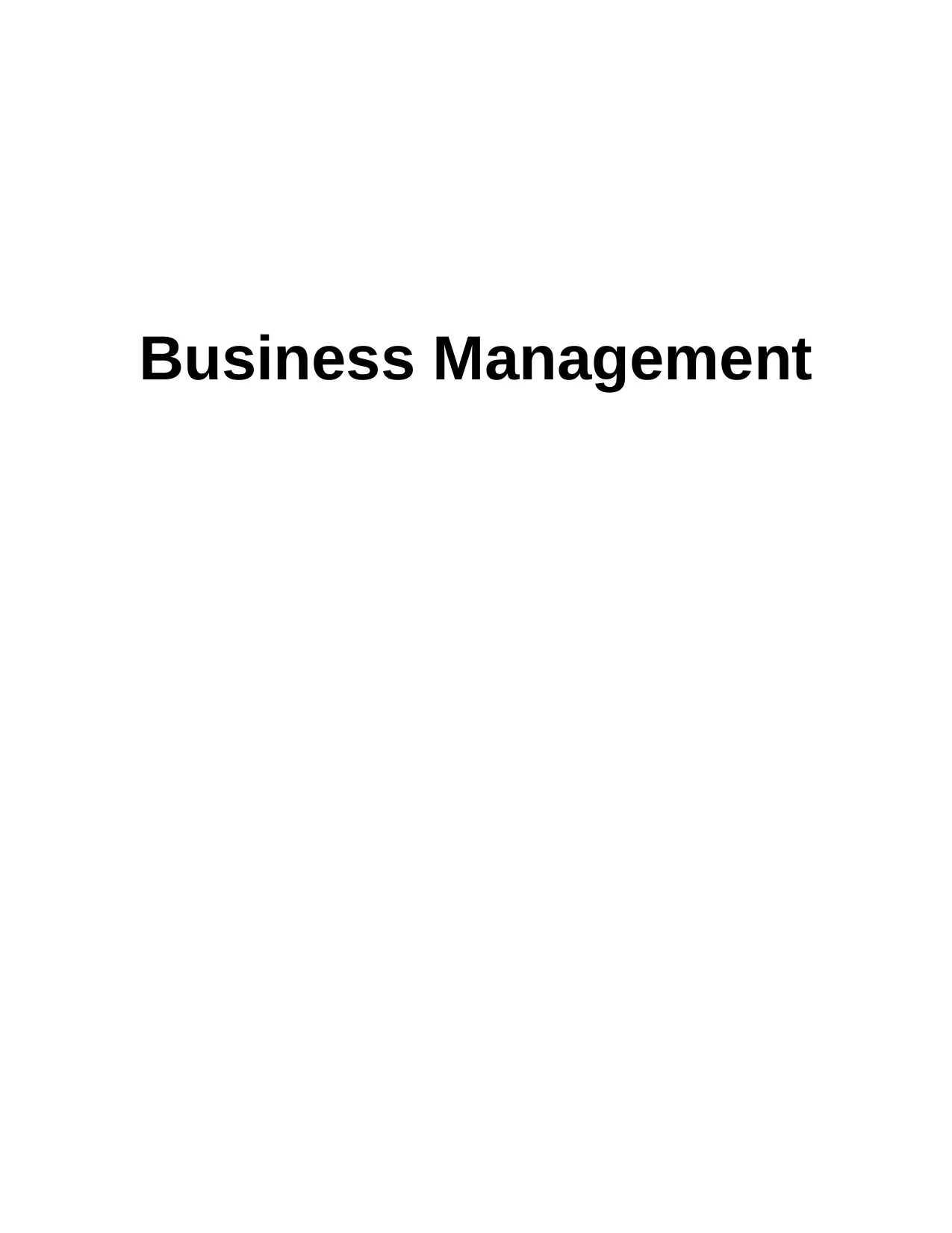
Business Management
Paraphrase This Document
Need a fresh take? Get an instant paraphrase of this document with our AI Paraphraser
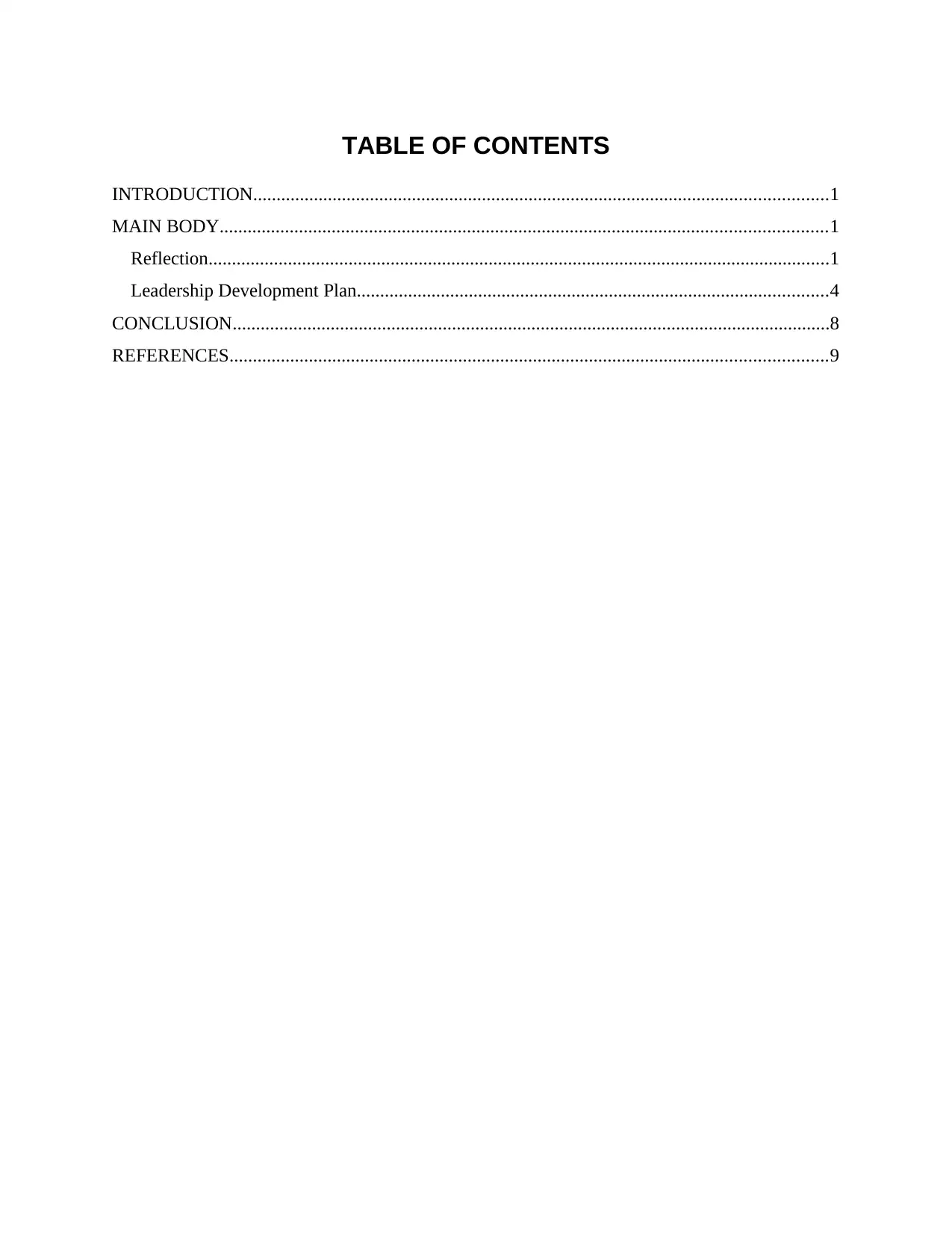
TABLE OF CONTENTS
INTRODUCTION...........................................................................................................................1
MAIN BODY..................................................................................................................................1
Reflection.....................................................................................................................................1
Leadership Development Plan.....................................................................................................4
CONCLUSION................................................................................................................................8
REFERENCES................................................................................................................................9
INTRODUCTION...........................................................................................................................1
MAIN BODY..................................................................................................................................1
Reflection.....................................................................................................................................1
Leadership Development Plan.....................................................................................................4
CONCLUSION................................................................................................................................8
REFERENCES................................................................................................................................9
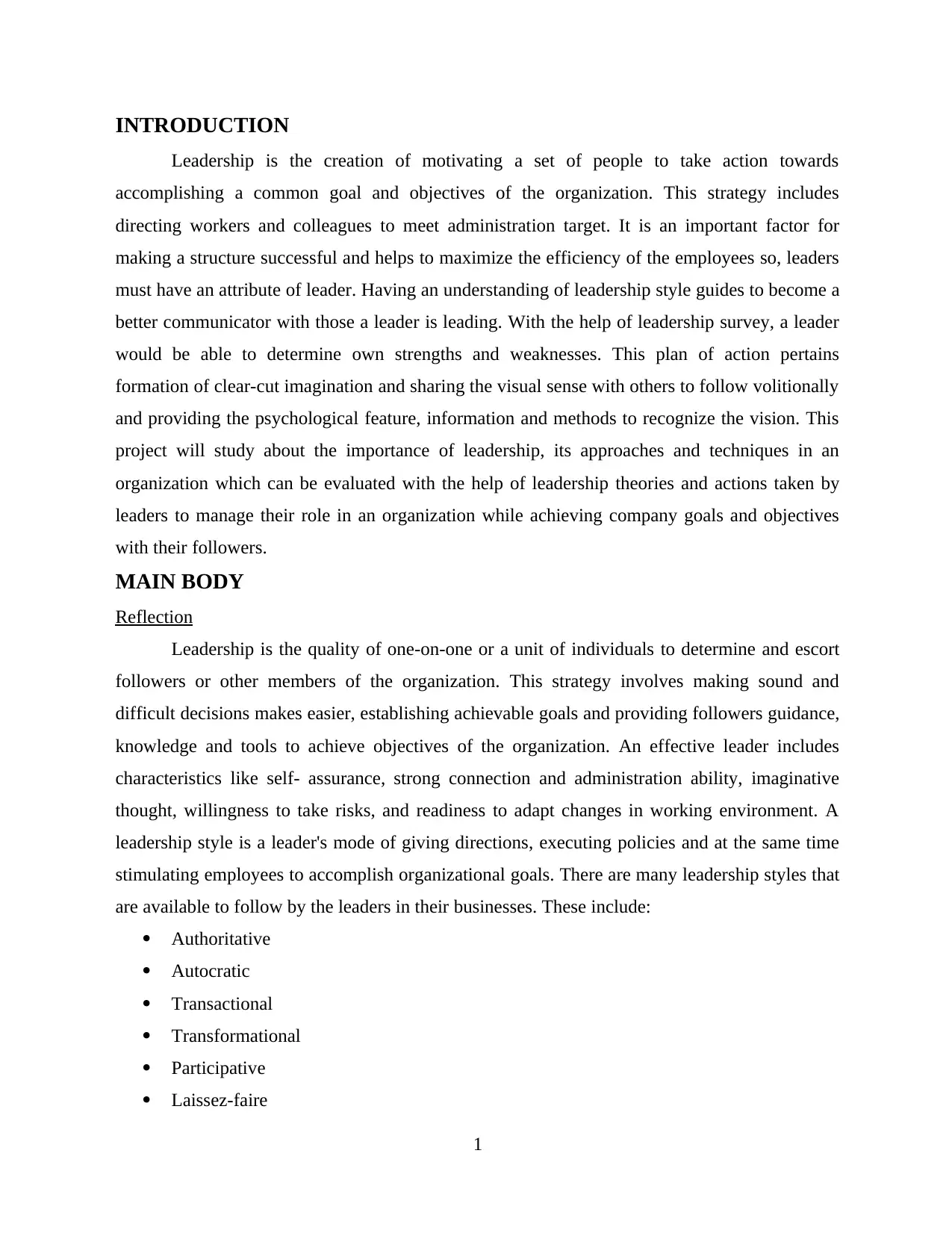
INTRODUCTION
Leadership is the creation of motivating a set of people to take action towards
accomplishing a common goal and objectives of the organization. This strategy includes
directing workers and colleagues to meet administration target. It is an important factor for
making a structure successful and helps to maximize the efficiency of the employees so, leaders
must have an attribute of leader. Having an understanding of leadership style guides to become a
better communicator with those a leader is leading. With the help of leadership survey, a leader
would be able to determine own strengths and weaknesses. This plan of action pertains
formation of clear-cut imagination and sharing the visual sense with others to follow volitionally
and providing the psychological feature, information and methods to recognize the vision. This
project will study about the importance of leadership, its approaches and techniques in an
organization which can be evaluated with the help of leadership theories and actions taken by
leaders to manage their role in an organization while achieving company goals and objectives
with their followers.
MAIN BODY
Reflection
Leadership is the quality of one-on-one or a unit of individuals to determine and escort
followers or other members of the organization. This strategy involves making sound and
difficult decisions makes easier, establishing achievable goals and providing followers guidance,
knowledge and tools to achieve objectives of the organization. An effective leader includes
characteristics like self- assurance, strong connection and administration ability, imaginative
thought, willingness to take risks, and readiness to adapt changes in working environment. A
leadership style is a leader's mode of giving directions, executing policies and at the same time
stimulating employees to accomplish organizational goals. There are many leadership styles that
are available to follow by the leaders in their businesses. These include:
Authoritative
Autocratic
Transactional
Transformational
Participative
Laissez-faire
1
Leadership is the creation of motivating a set of people to take action towards
accomplishing a common goal and objectives of the organization. This strategy includes
directing workers and colleagues to meet administration target. It is an important factor for
making a structure successful and helps to maximize the efficiency of the employees so, leaders
must have an attribute of leader. Having an understanding of leadership style guides to become a
better communicator with those a leader is leading. With the help of leadership survey, a leader
would be able to determine own strengths and weaknesses. This plan of action pertains
formation of clear-cut imagination and sharing the visual sense with others to follow volitionally
and providing the psychological feature, information and methods to recognize the vision. This
project will study about the importance of leadership, its approaches and techniques in an
organization which can be evaluated with the help of leadership theories and actions taken by
leaders to manage their role in an organization while achieving company goals and objectives
with their followers.
MAIN BODY
Reflection
Leadership is the quality of one-on-one or a unit of individuals to determine and escort
followers or other members of the organization. This strategy involves making sound and
difficult decisions makes easier, establishing achievable goals and providing followers guidance,
knowledge and tools to achieve objectives of the organization. An effective leader includes
characteristics like self- assurance, strong connection and administration ability, imaginative
thought, willingness to take risks, and readiness to adapt changes in working environment. A
leadership style is a leader's mode of giving directions, executing policies and at the same time
stimulating employees to accomplish organizational goals. There are many leadership styles that
are available to follow by the leaders in their businesses. These include:
Authoritative
Autocratic
Transactional
Transformational
Participative
Laissez-faire
1
⊘ This is a preview!⊘
Do you want full access?
Subscribe today to unlock all pages.

Trusted by 1+ million students worldwide
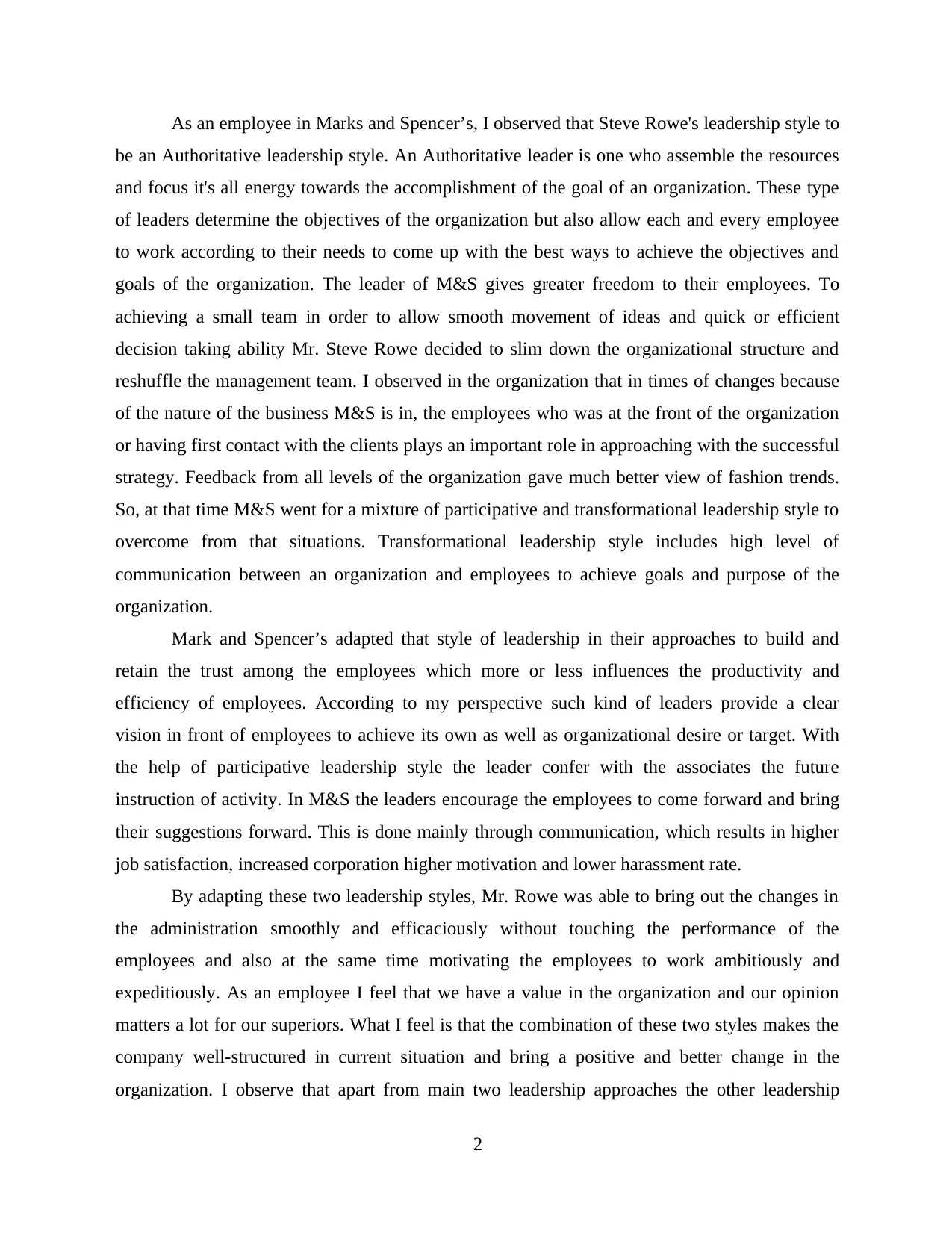
As an employee in Marks and Spencer’s, I observed that Steve Rowe's leadership style to
be an Authoritative leadership style. An Authoritative leader is one who assemble the resources
and focus it's all energy towards the accomplishment of the goal of an organization. These type
of leaders determine the objectives of the organization but also allow each and every employee
to work according to their needs to come up with the best ways to achieve the objectives and
goals of the organization. The leader of M&S gives greater freedom to their employees. To
achieving a small team in order to allow smooth movement of ideas and quick or efficient
decision taking ability Mr. Steve Rowe decided to slim down the organizational structure and
reshuffle the management team. I observed in the organization that in times of changes because
of the nature of the business M&S is in, the employees who was at the front of the organization
or having first contact with the clients plays an important role in approaching with the successful
strategy. Feedback from all levels of the organization gave much better view of fashion trends.
So, at that time M&S went for a mixture of participative and transformational leadership style to
overcome from that situations. Transformational leadership style includes high level of
communication between an organization and employees to achieve goals and purpose of the
organization.
Mark and Spencer’s adapted that style of leadership in their approaches to build and
retain the trust among the employees which more or less influences the productivity and
efficiency of employees. According to my perspective such kind of leaders provide a clear
vision in front of employees to achieve its own as well as organizational desire or target. With
the help of participative leadership style the leader confer with the associates the future
instruction of activity. In M&S the leaders encourage the employees to come forward and bring
their suggestions forward. This is done mainly through communication, which results in higher
job satisfaction, increased corporation higher motivation and lower harassment rate.
By adapting these two leadership styles, Mr. Rowe was able to bring out the changes in
the administration smoothly and efficaciously without touching the performance of the
employees and also at the same time motivating the employees to work ambitiously and
expeditiously. As an employee I feel that we have a value in the organization and our opinion
matters a lot for our superiors. What I feel is that the combination of these two styles makes the
company well-structured in current situation and bring a positive and better change in the
organization. I observe that apart from main two leadership approaches the other leadership
2
be an Authoritative leadership style. An Authoritative leader is one who assemble the resources
and focus it's all energy towards the accomplishment of the goal of an organization. These type
of leaders determine the objectives of the organization but also allow each and every employee
to work according to their needs to come up with the best ways to achieve the objectives and
goals of the organization. The leader of M&S gives greater freedom to their employees. To
achieving a small team in order to allow smooth movement of ideas and quick or efficient
decision taking ability Mr. Steve Rowe decided to slim down the organizational structure and
reshuffle the management team. I observed in the organization that in times of changes because
of the nature of the business M&S is in, the employees who was at the front of the organization
or having first contact with the clients plays an important role in approaching with the successful
strategy. Feedback from all levels of the organization gave much better view of fashion trends.
So, at that time M&S went for a mixture of participative and transformational leadership style to
overcome from that situations. Transformational leadership style includes high level of
communication between an organization and employees to achieve goals and purpose of the
organization.
Mark and Spencer’s adapted that style of leadership in their approaches to build and
retain the trust among the employees which more or less influences the productivity and
efficiency of employees. According to my perspective such kind of leaders provide a clear
vision in front of employees to achieve its own as well as organizational desire or target. With
the help of participative leadership style the leader confer with the associates the future
instruction of activity. In M&S the leaders encourage the employees to come forward and bring
their suggestions forward. This is done mainly through communication, which results in higher
job satisfaction, increased corporation higher motivation and lower harassment rate.
By adapting these two leadership styles, Mr. Rowe was able to bring out the changes in
the administration smoothly and efficaciously without touching the performance of the
employees and also at the same time motivating the employees to work ambitiously and
expeditiously. As an employee I feel that we have a value in the organization and our opinion
matters a lot for our superiors. What I feel is that the combination of these two styles makes the
company well-structured in current situation and bring a positive and better change in the
organization. I observe that apart from main two leadership approaches the other leadership
2
Paraphrase This Document
Need a fresh take? Get an instant paraphrase of this document with our AI Paraphraser

theories have been applied in Marks and Spencer’s at different levels for the fulfilment of their
objectives and goals towards the organization are classical management theory. With respect to
this theory, M&S trade with high manufacturing costs as their managers try to reduce the cost of
raw material by negotiating with its provider. The leaders of the organization stimulate us to get
through with new suppliers to maintain the consequences.
At certain levels the organization uses the contingency theory to minimize the risk and
the leaders play a vital role to make changes and help the employees to get through with the
industry conditions and changes occurred in the marketplace. Sometimes as an employee I
notice that to meet condition for various situations, the leaders of the following establishment
uses situational leadership style as this particular plan of action count on the skill and abilities of
the employees to accomplish the job within the time limit. System leadership strategy also
sometimes applied by leaders in the system to command worker presentation and connection in
various circumstances. It encourages the employees to execute according to the structural
stipulation. As an employee of the Mark and Spencer’s, I felt secure and viewed extremely
anticipated career.
Kind of consultative managers are also in the organization who pursue to refer other
employees also before making any decision. This type of leadership helps the employees to
become motivated and feel as important as the superiors in the organization. These type of
leaders have a great power of listening skill to their followers and also the aptitude to generate
accurate category of frequencies to refer its co-workers. In our organization, the culture of
consultation creates an environment that every person is involved in decision-making activities
of the corporation as well as draw their expert advices to their subordinates which helps to build
an impression in front of leaders and to show individual talents of making choices while doing
their work efficiently to achieve organizational as well as individual goals and objectives. For
example, the marketing department in our association uses consultation approach before
launching a new range of products in the market place. They conduct surveys within
organization and collection of feedbacks and opinions of concerned employees and then only
they are hastening towards the launch of a particular product for their consumers.
The leaders of the Mark and Spencer’s follow a process while doing their tasks to
complete their work efficiently. What I observe is that initially they create a vision keeping in
mind the goal of the organization. After they set the objectives for all of us to complete the
3
objectives and goals towards the organization are classical management theory. With respect to
this theory, M&S trade with high manufacturing costs as their managers try to reduce the cost of
raw material by negotiating with its provider. The leaders of the organization stimulate us to get
through with new suppliers to maintain the consequences.
At certain levels the organization uses the contingency theory to minimize the risk and
the leaders play a vital role to make changes and help the employees to get through with the
industry conditions and changes occurred in the marketplace. Sometimes as an employee I
notice that to meet condition for various situations, the leaders of the following establishment
uses situational leadership style as this particular plan of action count on the skill and abilities of
the employees to accomplish the job within the time limit. System leadership strategy also
sometimes applied by leaders in the system to command worker presentation and connection in
various circumstances. It encourages the employees to execute according to the structural
stipulation. As an employee of the Mark and Spencer’s, I felt secure and viewed extremely
anticipated career.
Kind of consultative managers are also in the organization who pursue to refer other
employees also before making any decision. This type of leadership helps the employees to
become motivated and feel as important as the superiors in the organization. These type of
leaders have a great power of listening skill to their followers and also the aptitude to generate
accurate category of frequencies to refer its co-workers. In our organization, the culture of
consultation creates an environment that every person is involved in decision-making activities
of the corporation as well as draw their expert advices to their subordinates which helps to build
an impression in front of leaders and to show individual talents of making choices while doing
their work efficiently to achieve organizational as well as individual goals and objectives. For
example, the marketing department in our association uses consultation approach before
launching a new range of products in the market place. They conduct surveys within
organization and collection of feedbacks and opinions of concerned employees and then only
they are hastening towards the launch of a particular product for their consumers.
The leaders of the Mark and Spencer’s follow a process while doing their tasks to
complete their work efficiently. What I observe is that initially they create a vision keeping in
mind the goal of the organization. After they set the objectives for all of us to complete the
3

vision of particular task. Then construction of approaches takes place to accomplish those
objectives. After construction of strategies, development of change process occurs if required.
After that the change process has been illustrated in front of all concerned employees and the
subordinates for further guidance. The subordinates motivate all of us to adapt changes and to
complete our tasks in an efficient manner. After that, our work begins to implement those
strategies into our work culture for the fulfilment of those objectives which more or less
influences the image of the institute as well as us in a distinctive manner. After the
implementation of strategies, the leaders and subordinates analyse the results whether the work
require further improvements or not or the work was sufficient to achieve objectives of the
association.
In my opinion the Mark and Spencer’s is a place where employees are allowed to do
what they feel correct. It does not mean that the subordinates did not notice the working of the
employees, they have an eye on the performances of the employees exactly what they are doing
with an immense judgement with respect to their work. In short I can say that the firm executed
more categorical human associations strategy.
Leadership Development Plan
Leadership
development
objectives
Activities of a leader
that will help in
achieving leadership
objectives
Where will these
leadership objectives
be developed
Target date for
achieving leadership
objectives
4
objectives. After construction of strategies, development of change process occurs if required.
After that the change process has been illustrated in front of all concerned employees and the
subordinates for further guidance. The subordinates motivate all of us to adapt changes and to
complete our tasks in an efficient manner. After that, our work begins to implement those
strategies into our work culture for the fulfilment of those objectives which more or less
influences the image of the institute as well as us in a distinctive manner. After the
implementation of strategies, the leaders and subordinates analyse the results whether the work
require further improvements or not or the work was sufficient to achieve objectives of the
association.
In my opinion the Mark and Spencer’s is a place where employees are allowed to do
what they feel correct. It does not mean that the subordinates did not notice the working of the
employees, they have an eye on the performances of the employees exactly what they are doing
with an immense judgement with respect to their work. In short I can say that the firm executed
more categorical human associations strategy.
Leadership Development Plan
Leadership
development
objectives
Activities of a leader
that will help in
achieving leadership
objectives
Where will these
leadership objectives
be developed
Target date for
achieving leadership
objectives
4
⊘ This is a preview!⊘
Do you want full access?
Subscribe today to unlock all pages.

Trusted by 1+ million students worldwide
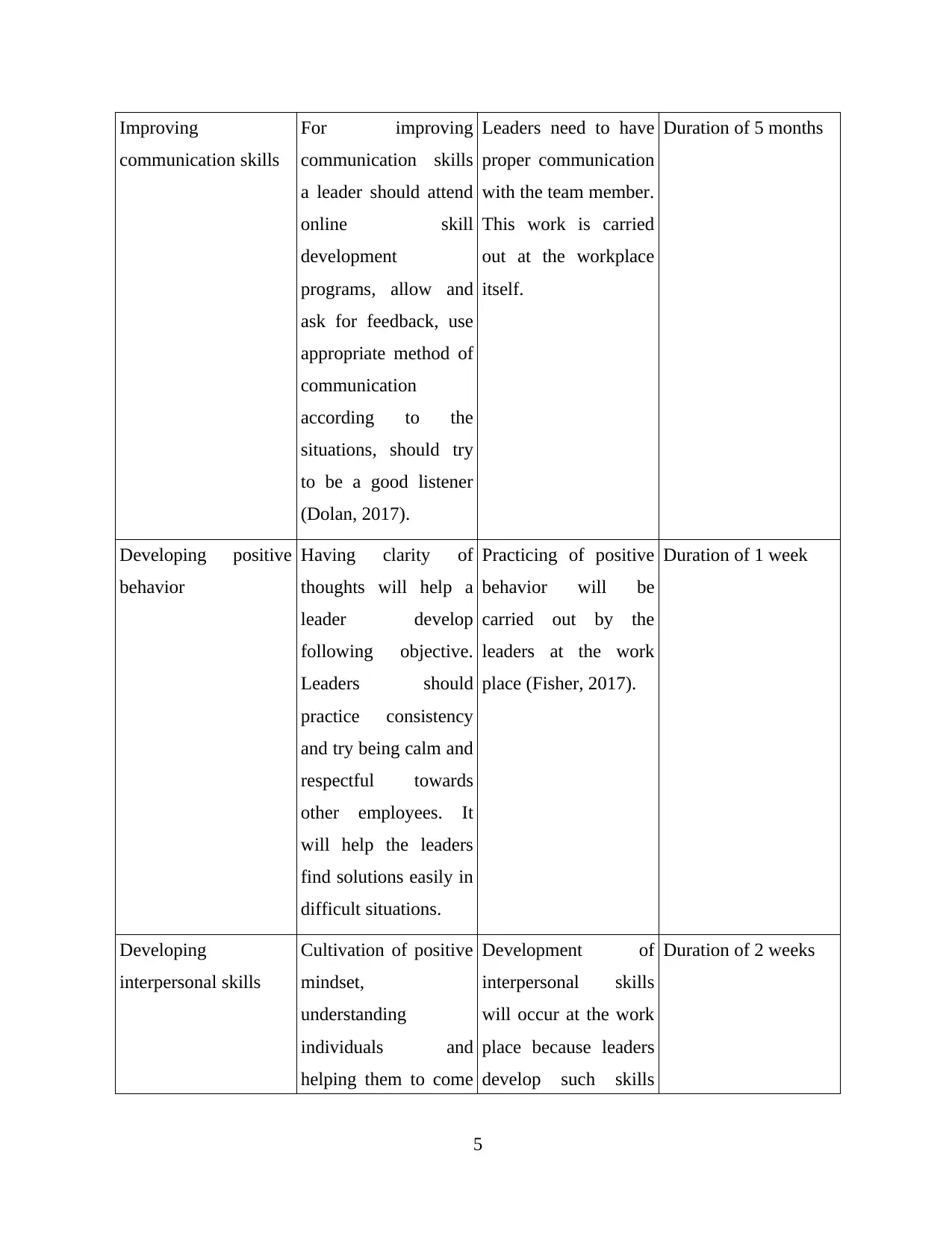
Improving
communication skills
For improving
communication skills
a leader should attend
online skill
development
programs, allow and
ask for feedback, use
appropriate method of
communication
according to the
situations, should try
to be a good listener
(Dolan, 2017).
Leaders need to have
proper communication
with the team member.
This work is carried
out at the workplace
itself.
Duration of 5 months
Developing positive
behavior
Having clarity of
thoughts will help a
leader develop
following objective.
Leaders should
practice consistency
and try being calm and
respectful towards
other employees. It
will help the leaders
find solutions easily in
difficult situations.
Practicing of positive
behavior will be
carried out by the
leaders at the work
place (Fisher, 2017).
Duration of 1 week
Developing
interpersonal skills
Cultivation of positive
mindset,
understanding
individuals and
helping them to come
Development of
interpersonal skills
will occur at the work
place because leaders
develop such skills
Duration of 2 weeks
5
communication skills
For improving
communication skills
a leader should attend
online skill
development
programs, allow and
ask for feedback, use
appropriate method of
communication
according to the
situations, should try
to be a good listener
(Dolan, 2017).
Leaders need to have
proper communication
with the team member.
This work is carried
out at the workplace
itself.
Duration of 5 months
Developing positive
behavior
Having clarity of
thoughts will help a
leader develop
following objective.
Leaders should
practice consistency
and try being calm and
respectful towards
other employees. It
will help the leaders
find solutions easily in
difficult situations.
Practicing of positive
behavior will be
carried out by the
leaders at the work
place (Fisher, 2017).
Duration of 1 week
Developing
interpersonal skills
Cultivation of positive
mindset,
understanding
individuals and
helping them to come
Development of
interpersonal skills
will occur at the work
place because leaders
develop such skills
Duration of 2 weeks
5
Paraphrase This Document
Need a fresh take? Get an instant paraphrase of this document with our AI Paraphraser
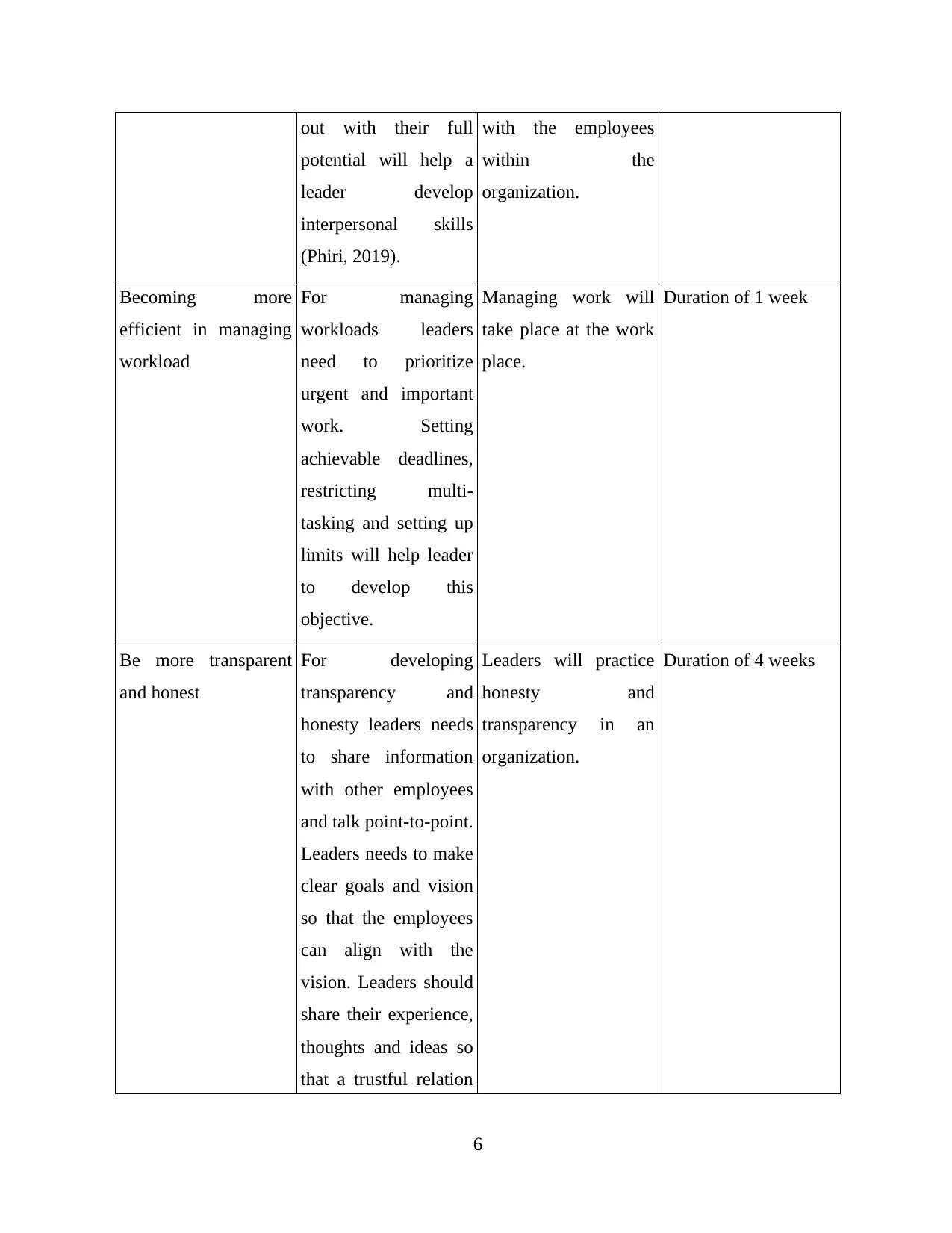
out with their full
potential will help a
leader develop
interpersonal skills
(Phiri, 2019).
with the employees
within the
organization.
Becoming more
efficient in managing
workload
For managing
workloads leaders
need to prioritize
urgent and important
work. Setting
achievable deadlines,
restricting multi-
tasking and setting up
limits will help leader
to develop this
objective.
Managing work will
take place at the work
place.
Duration of 1 week
Be more transparent
and honest
For developing
transparency and
honesty leaders needs
to share information
with other employees
and talk point-to-point.
Leaders needs to make
clear goals and vision
so that the employees
can align with the
vision. Leaders should
share their experience,
thoughts and ideas so
that a trustful relation
Leaders will practice
honesty and
transparency in an
organization.
Duration of 4 weeks
6
potential will help a
leader develop
interpersonal skills
(Phiri, 2019).
with the employees
within the
organization.
Becoming more
efficient in managing
workload
For managing
workloads leaders
need to prioritize
urgent and important
work. Setting
achievable deadlines,
restricting multi-
tasking and setting up
limits will help leader
to develop this
objective.
Managing work will
take place at the work
place.
Duration of 1 week
Be more transparent
and honest
For developing
transparency and
honesty leaders needs
to share information
with other employees
and talk point-to-point.
Leaders needs to make
clear goals and vision
so that the employees
can align with the
vision. Leaders should
share their experience,
thoughts and ideas so
that a trustful relation
Leaders will practice
honesty and
transparency in an
organization.
Duration of 4 weeks
6
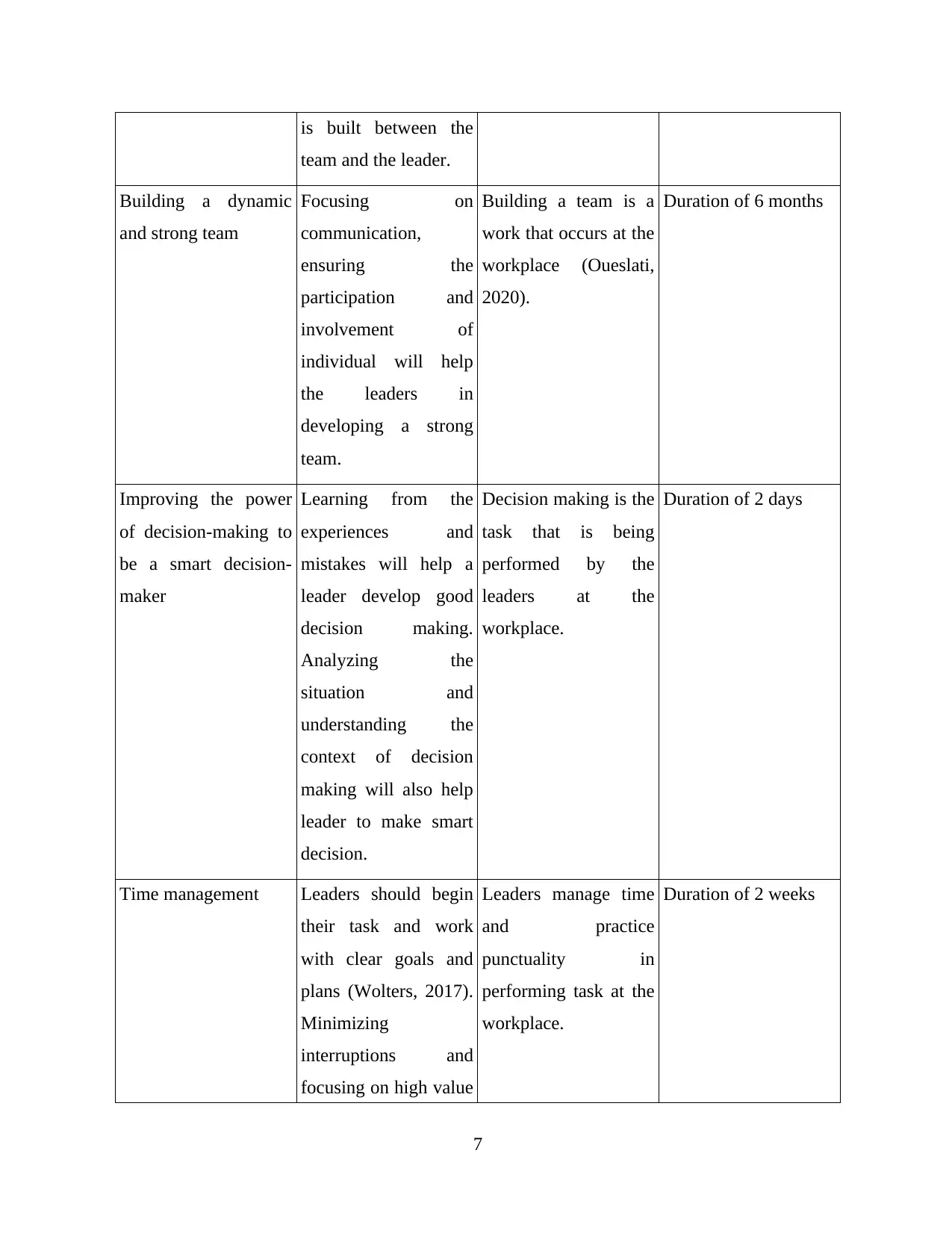
is built between the
team and the leader.
Building a dynamic
and strong team
Focusing on
communication,
ensuring the
participation and
involvement of
individual will help
the leaders in
developing a strong
team.
Building a team is a
work that occurs at the
workplace (Oueslati,
2020).
Duration of 6 months
Improving the power
of decision-making to
be a smart decision-
maker
Learning from the
experiences and
mistakes will help a
leader develop good
decision making.
Analyzing the
situation and
understanding the
context of decision
making will also help
leader to make smart
decision.
Decision making is the
task that is being
performed by the
leaders at the
workplace.
Duration of 2 days
Time management Leaders should begin
their task and work
with clear goals and
plans (Wolters, 2017).
Minimizing
interruptions and
focusing on high value
Leaders manage time
and practice
punctuality in
performing task at the
workplace.
Duration of 2 weeks
7
team and the leader.
Building a dynamic
and strong team
Focusing on
communication,
ensuring the
participation and
involvement of
individual will help
the leaders in
developing a strong
team.
Building a team is a
work that occurs at the
workplace (Oueslati,
2020).
Duration of 6 months
Improving the power
of decision-making to
be a smart decision-
maker
Learning from the
experiences and
mistakes will help a
leader develop good
decision making.
Analyzing the
situation and
understanding the
context of decision
making will also help
leader to make smart
decision.
Decision making is the
task that is being
performed by the
leaders at the
workplace.
Duration of 2 days
Time management Leaders should begin
their task and work
with clear goals and
plans (Wolters, 2017).
Minimizing
interruptions and
focusing on high value
Leaders manage time
and practice
punctuality in
performing task at the
workplace.
Duration of 2 weeks
7
⊘ This is a preview!⊘
Do you want full access?
Subscribe today to unlock all pages.

Trusted by 1+ million students worldwide
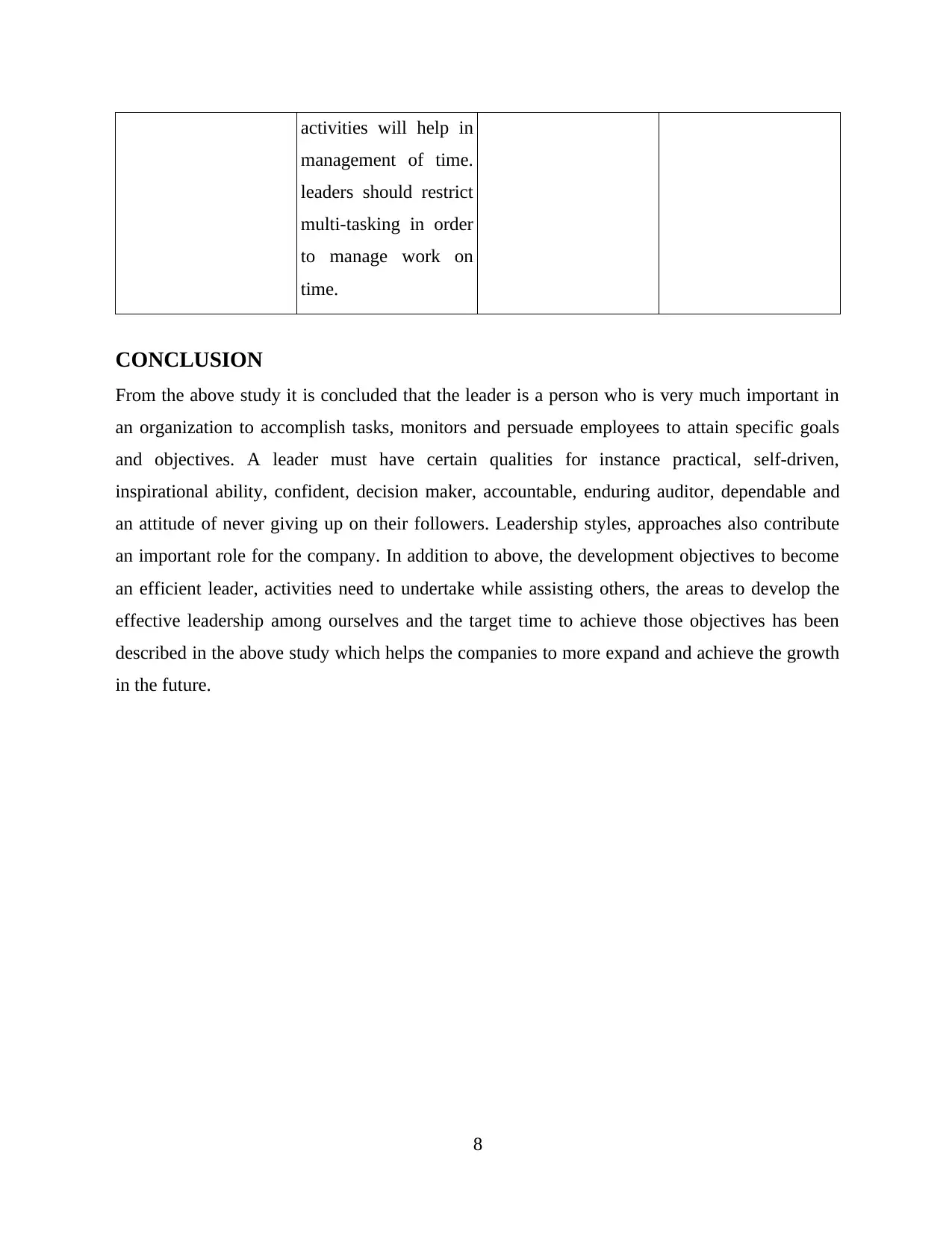
activities will help in
management of time.
leaders should restrict
multi-tasking in order
to manage work on
time.
CONCLUSION
From the above study it is concluded that the leader is a person who is very much important in
an organization to accomplish tasks, monitors and persuade employees to attain specific goals
and objectives. A leader must have certain qualities for instance practical, self-driven,
inspirational ability, confident, decision maker, accountable, enduring auditor, dependable and
an attitude of never giving up on their followers. Leadership styles, approaches also contribute
an important role for the company. In addition to above, the development objectives to become
an efficient leader, activities need to undertake while assisting others, the areas to develop the
effective leadership among ourselves and the target time to achieve those objectives has been
described in the above study which helps the companies to more expand and achieve the growth
in the future.
8
management of time.
leaders should restrict
multi-tasking in order
to manage work on
time.
CONCLUSION
From the above study it is concluded that the leader is a person who is very much important in
an organization to accomplish tasks, monitors and persuade employees to attain specific goals
and objectives. A leader must have certain qualities for instance practical, self-driven,
inspirational ability, confident, decision maker, accountable, enduring auditor, dependable and
an attitude of never giving up on their followers. Leadership styles, approaches also contribute
an important role for the company. In addition to above, the development objectives to become
an efficient leader, activities need to undertake while assisting others, the areas to develop the
effective leadership among ourselves and the target time to achieve those objectives has been
described in the above study which helps the companies to more expand and achieve the growth
in the future.
8
Paraphrase This Document
Need a fresh take? Get an instant paraphrase of this document with our AI Paraphraser

REFERENCES
Books and Journals
Anderson, M., 2017. Transformational leadership in education: A review of existing
literature. International Social Science Review. 93(1). p.4.
Ciulla, J.B., 2020. The importance of leadership in shaping business values. In The Search for
Ethics in Leadership, Business, and Beyond (pp. 153-163). Springer, Cham.
Dolan, R., 2017. Branding yourself effective communication skills. Microbiology
Letters. 364(2). p.fnw289.
Fiaz, M., Su, Q. and Saqib, A., 2017. Leadership styles and employees' motivation: Perspective
from an emerging economy. The Journal of Developing Areas. 51(4). pp.143-156.
Fisher, L., Polonsky, W.H., Hessler, D. and Potter, M.B., 2017. A practical framework for
encouraging and supporting positive behaviour change in diabetes. Diabetic
Medicine. 34(12). pp.1658-1666.
Hughes, and et.al., 2018. Leadership, creativity, and innovation: A critical review and practical
recommendations. The Leadership Quarterly. 29(5). pp.549-569.
Oueslati, and et.al., 2020. Opinion leaders' detection in dynamic social networks. Concurrency
and Computation: Practice and Experience, p.e5692.
Phiri, A., Bano, N. and Raouf, A., 2019. Interpersonal skills and emotion management: Impact
of social leadership on job satisfaction of workers. Advances in Developmental and
Educational Psychology. 1(1). pp.1-6.
Reunanen, T. and Kaitonen, J., 2017. Different roles in leadership styles in modern organization.
In Advances in human factors, business management, training and education (pp. 251-
262). Springer, Cham.
Rudolph, C.W., Rauvola, R.S. and Zacher, H., 2018. Leadership and generations at work: A
critical review. The Leadership Quarterly. 29(1). pp.44-57.
Wolters, C.A., Won, S. and Hussain, M., 2017. Examining the relations of time management
and procrastination within a model of self-regulated learning. Metacognition and
learning. 12(3). pp.381-399.
9
Books and Journals
Anderson, M., 2017. Transformational leadership in education: A review of existing
literature. International Social Science Review. 93(1). p.4.
Ciulla, J.B., 2020. The importance of leadership in shaping business values. In The Search for
Ethics in Leadership, Business, and Beyond (pp. 153-163). Springer, Cham.
Dolan, R., 2017. Branding yourself effective communication skills. Microbiology
Letters. 364(2). p.fnw289.
Fiaz, M., Su, Q. and Saqib, A., 2017. Leadership styles and employees' motivation: Perspective
from an emerging economy. The Journal of Developing Areas. 51(4). pp.143-156.
Fisher, L., Polonsky, W.H., Hessler, D. and Potter, M.B., 2017. A practical framework for
encouraging and supporting positive behaviour change in diabetes. Diabetic
Medicine. 34(12). pp.1658-1666.
Hughes, and et.al., 2018. Leadership, creativity, and innovation: A critical review and practical
recommendations. The Leadership Quarterly. 29(5). pp.549-569.
Oueslati, and et.al., 2020. Opinion leaders' detection in dynamic social networks. Concurrency
and Computation: Practice and Experience, p.e5692.
Phiri, A., Bano, N. and Raouf, A., 2019. Interpersonal skills and emotion management: Impact
of social leadership on job satisfaction of workers. Advances in Developmental and
Educational Psychology. 1(1). pp.1-6.
Reunanen, T. and Kaitonen, J., 2017. Different roles in leadership styles in modern organization.
In Advances in human factors, business management, training and education (pp. 251-
262). Springer, Cham.
Rudolph, C.W., Rauvola, R.S. and Zacher, H., 2018. Leadership and generations at work: A
critical review. The Leadership Quarterly. 29(1). pp.44-57.
Wolters, C.A., Won, S. and Hussain, M., 2017. Examining the relations of time management
and procrastination within a model of self-regulated learning. Metacognition and
learning. 12(3). pp.381-399.
9
1 out of 11
Related Documents
Your All-in-One AI-Powered Toolkit for Academic Success.
+13062052269
info@desklib.com
Available 24*7 on WhatsApp / Email
![[object Object]](/_next/static/media/star-bottom.7253800d.svg)
Unlock your academic potential
Copyright © 2020–2025 A2Z Services. All Rights Reserved. Developed and managed by ZUCOL.





